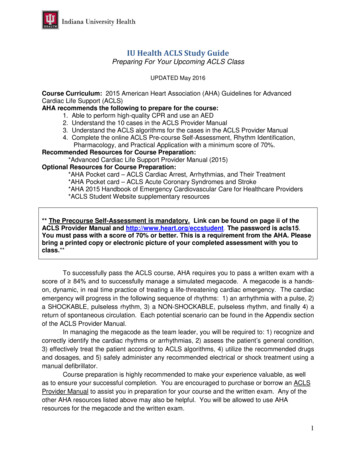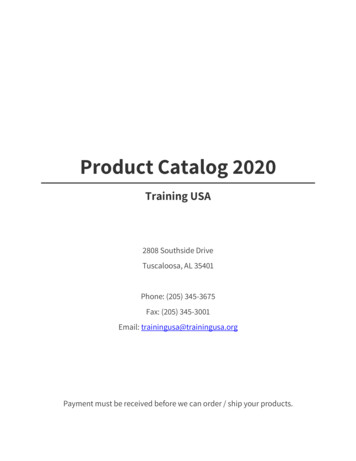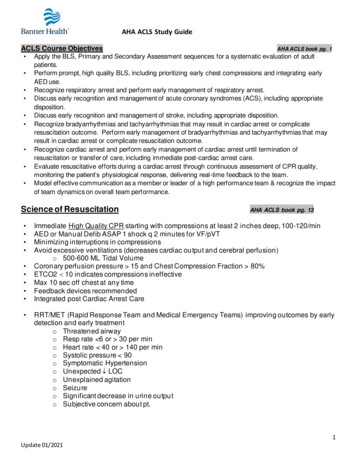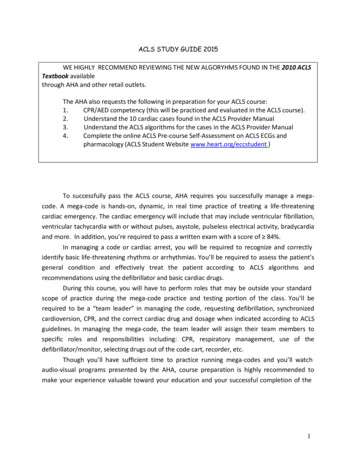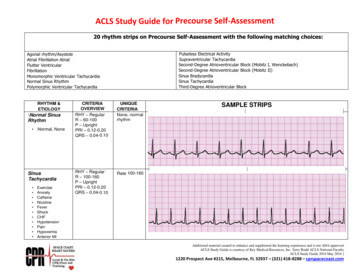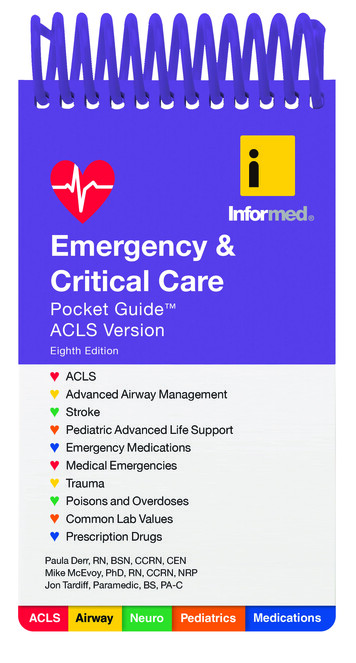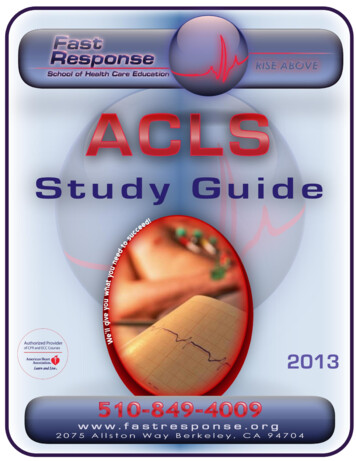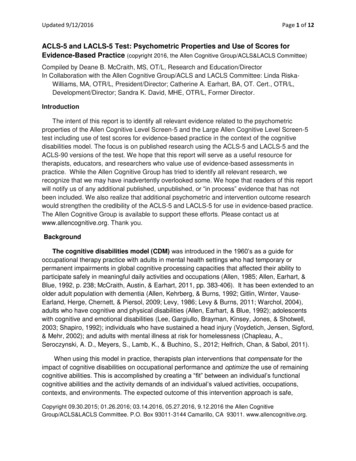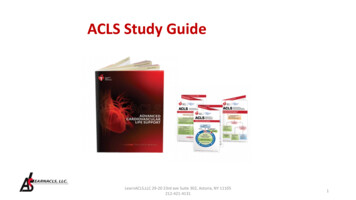
Transcription
ACLS Study GuideLearnACLS,LLC 29-20 23rd ave Suite 302, Astoria, NY 11105212-421-41311
Welcome to LearnACLS a multi-regional and international American Heart Association Training Center, the home of “StressFree Leaning”.Before attending your class, it is mandatory that you complete the precourse online assessment. The links are:Precourse Assessment https://elearning.heart.org/course/423This self-evaluation is designed to prepare you for your upcoming certification class, as well as assist the instructors inguiding the class meet your educational needs.If you register and pay 10 days prior to the class, you may choose to receive your course materials shipped to you for anadditional 9.00. Please take the opportunity to review the materials prior to attending your course. Enclosed you will finda quick reference study guide which we have prepared to assist you in preparing for your course. This guide is not meant toreplace your AHA materials but to facilitate your learning.Upon successful course completion, including demonstration of skills competency in all learning stations and passing theCPR and AED skills test, bag-mask ventilation skills test, a Megacode test and a written test, students receive an ACLS coursecompletion card, valid for two years. Once again thank you for choosing LearnACLS for your American Heart Associationtraining needs. We look forward to seeing you at your class.LearnACLS,LLC 29-20 23rd ave Suite 302, Astoria, NY 11105212-421-41312
High quality CPR and early defibrillator is the core of ACLS care in the cardiac arrest patient.High quality CPR can be measured by, Partial End Tidal Carbon Dioxide (PETCO2). A reading greater than 10 and less than 23indicates high quality CPR. The normal PETCO is 35-45 mm HG. Any reading less than 10 indicates ineffectiveness CPRduring resuscitation.A sudden rise of PETCO towards normal is the first sign of return spontaneous circulation (ROSC).If an AED does not analyze it is defective, do not attempt to troubleshoot.Integration of the Rapid Response Team (RRT) or Medical Emergency Team (MET) facilities early identification of clinicaldeterioration of patients and visitors in hospital and improves overall outcome.Atropine is not recommended for routing use in Asystole or PEA.Pulseless Electrical activity is finding of a rhythm that would normally profuse but is not.LearnACLS,LLC 29-20 23rd ave Suite 302, Astoria, NY 11105212-421-41313
All symptomatic bradycardiac patients should receive Atropine 1mg IVB every 3-5 minutes up to 3 mg. Those patients whodo not respond may be treated with Dopamine or Epinephrine infusions or Transcutaneous pacing.Any regular tachycardia is to be considered unstable and the treatment of choice should be synchronized cardioversion,with or without sedation.In Return of Spontaneous Circulation (ROSC) algorithms the first priority is to maintain airway, the overall focus ismaintenance of homeostasis. Percutaneous Coronary Intervention (PCI) and induction of therapeutic hypothermia canbe safely combined.Target values after ROSC, PAO2 / FIO2 94-98, PETCO2 35-45, BP 90 mm HG systolic.ROSC patients can receive 1-2L of 4-degree Celsius of Saline or Ringers.In Bradycardia and Tachycardia always consider underlying causes as first line treatment.LearnACLS,LLC 29-20 23rd ave Suite 302, Astoria, NY 11105212-421-41314
The rate of chest compressions is 100 to 120 compressions. Adult a depth between 2 to 2.4 inches (5-6cm)HCP will provide rescue breaths for the adult at a rate of 1breath every 5-6 sec. (10-12/min); Once an advanced airway is inplace continuous CPR with 1 ventilation every 6 sec. (10/min)Post Cardiac Arrest Therapeutic Hypothermia-Targeted Temperature Management (TMM) is in the range of 32⁰-36⁰C for 24hours.Synchronized Cardioversion for Unstable Tachycardias-Initial energy for Narrow Regular (atrial flutter) or (SVT) 50-100 JInitial energy dose for cardioversion for Narrow Irregular (atrial fibrillation) is 120-200 J; Initial energy for Wide Regular(monomorphic VT ) is 100 JPacing-Transcutaneous pacing (TCP) is considered for symptomatic bradycardia with a pulse if atropine is ineffective; NOTrecommended for asystolic cardiac arrest. If TCP fails, transvenous pacing should be initiated by a trained provider.Capnography--It is the most reliable method to confirm ET tube placement. Normal PETCO2 values 35-40mmHg. PETCO2values 10 mmHg during CPR suggest chest compressions are effective, if values are less than 10 mm HG, - improve chestcompressions (depth, placement, rate) and vasopressor therapy.Colormetric ETCO2 devices should be used only when waveform capnography is not available.LearnACLS,LLC 29-20 23rd ave Suite 302, Astoria, NY 11105212-421-41315
Key changes in advanced cardiovascular life support, reflecting the 2020 American Heart Association Guidelinesfor Cardiopulmonary Resuscitation and Emergency Cardiovascular Care Basic life support skills, including effective chest compressions monitored by a CPR Coach, use of a bag-maskdevice with a filter and use of an (AED) Recognition and early management of respiratory and cardiac arrest Recognition and early management of peri-arrest conditions such as symptomatic bradycardia Airway management Related pharmacology Management of acute coronary syndromes (ACS) and stroke Effective communication as a member and leader of a resuscitation team Effective Resuscitation Team DynamicsLearnACLS,LLC 29-20 23rd ave Suite 302, Astoria, NY 11105212-421-41316
LearnACLS,LLC 29-20 23rd ave Suite 302, Astoria, NY 11105212-421-41317
Monitor;CPR CoachLearnACLS,LLC 29-20 23rd ave Suite 302, Astoria, NY 11105212-421-41318
LearnACLS,LLC 29-20 23rd ave Suite 302, Astoria, NY 11105212-421-41319
LearnACLS,LLC 29-20 23rd ave Suite 302, Astoria, NY 11105212-421-413110
LearnACLS,LLC 29-20 23rd ave Suite 302, Astoria, NY 11105212-421-413111
LearnACLS,LLC 29-20 23rd ave Suite 302, Astoria, NY 11105212-421-413112
ACLS Study Guide. LearnACLS,LLC 29-20 23rd ave Suite 302, Astoria, NY 11105 . replace your AHA materials but to facilitate your learning. . transvenous pacing should be initiated by a trained provider. Capnography--It is the most reliable method to confirm ET tube placement. Normal PETCO 2 values 35-40mmHg. PETCO
